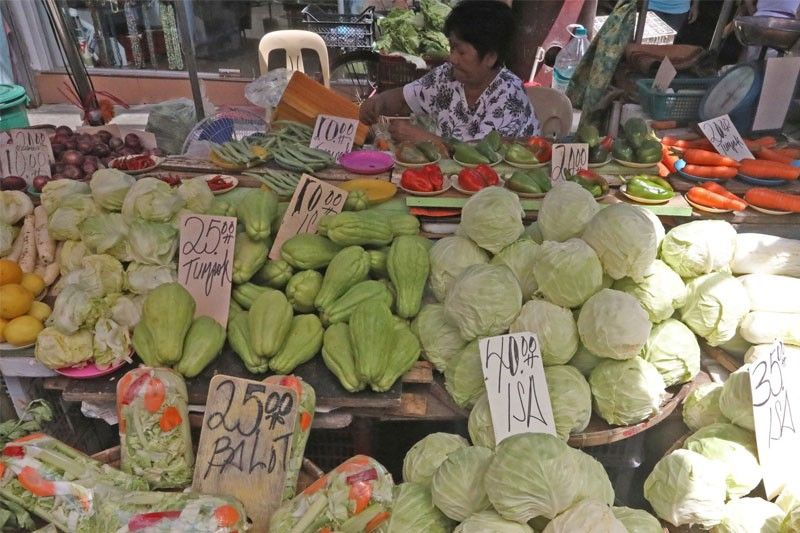August inflation seen above 6%

MANILA, Philippines — Inflation likely remained elevated, staying above six percent for the third straight month in August due to rising global oil prices as well as increasing demand for goods and services as the economy further reopens from strict COVID quarantine and lockdown protocols, according to economists.
Unionbank chief economist Ruben Carlo Asuncion said the August inflation likely settled at 6.7 percent after accelerating to 6.4 percent in July from 6.1 percent in June.
“Again, the main factors are the elevated global oil prices and the rising domestic demand for goods and services as the economy continues to move away from the impact of the pandemic. Food and transport prices have continued to rise,” Asuncion said.
The Aboitiz-led bank sees inflation peaking in September before easing to slightly above six percent by December.
It also expects the Bangko Sentral ng Pilipinas (BSP) to hike interest rates by another 25 basis points this month before a hawkish pause for the two remaining rate-setting meetings in November and December.
However, Asuncion said that an August inflation threading near seven percent may push the Monetary Board to raise interest rates by 25 basis points more than what the public initially expects.
Asuncion said the recent pronouncement made by the US Federal Reserve of further rate hikes in the coming months puts in danger the bank’s view that the overnight reverse repurchase rate would end the year at four percent.
“We’re currently expecting four percent, but it seems the US Fed’s firmness on its plans of more rate hikes is putting this view in danger. Nevertheless, we think that the BSP will be in a hawkish pause, evaluating how its recent hikes are working through the economy. Although we know that monetary policy works at a lag, we take the cue from the BSP stance of being data-dependent on its next moves,” Asuncion said.
Philippine National Bank economist Alvin Arogo said inflation likely reached 6.6 percent in August and is expected to accelerate further and average 8.2 percent in the fourth quarter.
“This would be driven by the delayed impact of higher fertilizer prices on key food items, second-round effects from minimum wage hike, higher rent for residence, and higher price adjustments from restaurants and cafes. All of these will be pushed by the higher cost of fuel and other key commodities,” Arogo said.
The bank owned by tobacco and airline magnate Lucio Tan believes monetary authorities need to continue raising the policy rate to help combat high inflation and to prevent the peso from depreciating further after hitting an all-time low of 56.77 to $1 last Friday.
“We forecast that the reverse repurchase rate will reach 4.25 percent by the end of this year, although this could be revised up if the Fed hikes for the remainder of 2022 are more than expected,” Arogo said.
The BSP has so far raised key policy rates by 175 basis points, bringing the benchmark rate to 3.75 percent from an all-time low of two percent, as it continues to fight mounting inflationary pressures.
Last Aug. 18, the central bank raised its inflation forecast to 5.4 percent for this year as inflation averaged 4.7 percent in the first seven months, above the BSP’s two to four percent target.
Jun Neri, lead economist at Ayala-led Bank of the Philippine Islands, said inflation may have slightly risen to 6.5 percent in August from 6.4 percent in July as food price increases appear to have outweighed the petroleum price rollbacks, translating to an estimated 0.6 percent month-on-month increase in the consumer price index.
“So far, inflation appears to be a bigger growth damper on growth than rising interest rates. We have observed a slowdown in spending on discretionaries and services like restaurants, dragged by rapid inflation and peso depreciation,” Neri said.
According to Neri, the 171-year-old bank has not increased charges on credit cards despite the tightening cycle by the BSP, which somewhat indicates that consumer demand has not been constrained by monetary tightening yet.
“As domestic inflation continues to rise, recovery to pre-COVID growth consumption trajectory will likely take longer,” Neri said.
Security Bank chief economist Robert Dan Roces projects August inflation at 6.4 percent with a range of 6.2 to 6.6 percent with the food basket is estimated to have contributed approximately 2.3 percent.
Roces said food was the prime inflationary factor especially with Typhoon Florita’s damage, on top of the prolonged sugar shortage.
“Offsetting this is lower global oil prices and lower costs of other food stuff. Price growth remain mostly cost-push driven amid some demand-side recovery. Upside risks coming from global factors remain significant,” Roces said.
ING Bank senior economist Nicholas Mapa said the planned transport fare adjustment would likely push inflation to peak at seven percent by October and ensure inflation stays elevated going into 2023.
Mapa said inflation was steady at 6.4 percent in August as pricey food, transport and utilities showcase the negative impact of the fallout from the Russia-Ukraine war and the work stoppages in China.
“These first round effects continue to feed through, however, to the rest of the CPI basket causing second round effects such as wage and transport price increases as well as reactionary price increases like increase in canned foods and noodles,” Mapa added.
On the other hand, China Bank chief economist Domini Velasquez and Rizal Commercial Banking Corp. Michael Ricafort believe inflation eased slightly to 6.3 percent in August from 6.4 percent in July amid the series of rollback in local fuel pump prices since July.
However, Velasquez said inflation would still likely peak at 6.7 percent in October.
Ricafort also cited the appreciation of the peso back to the 55 to $1 in July after touching the all-time low of 56.45 to $1 intraday on July 12 and 14, prompting the BSP to deliver a huge 75-basis-point hike in a surprise off-cycle meeting last July 14.
“Inflation could still peak around October at below seven percent and could mathematically ease thereafter. Thus, further local policy rate hikes could still be possible for the coming months, as supported by generally strong economic data; also as a function of future Fed rate hikes as well as the behavior of the peso exchange rate, going forward,” Ricafort said.
- Latest
- Trending





























